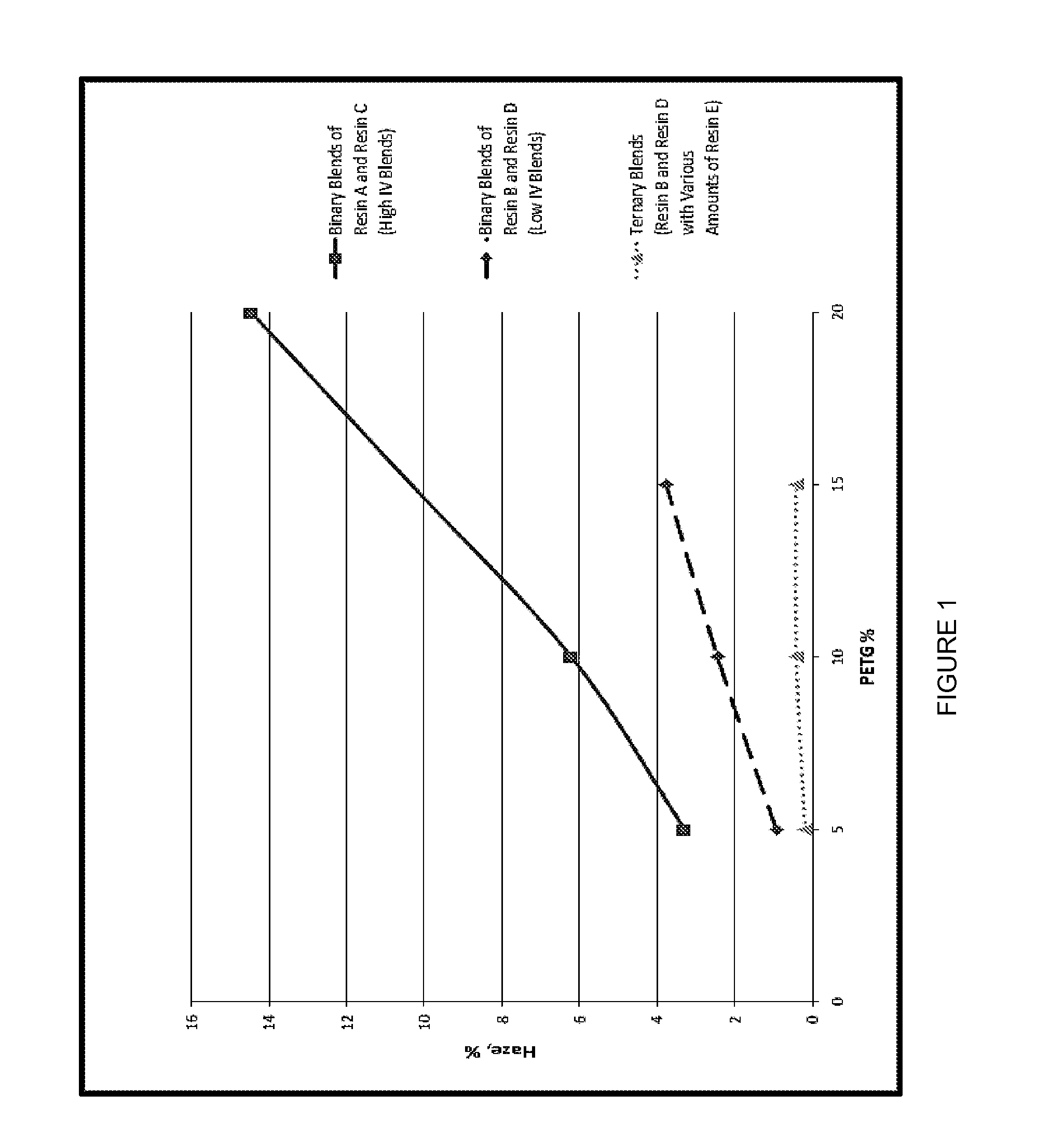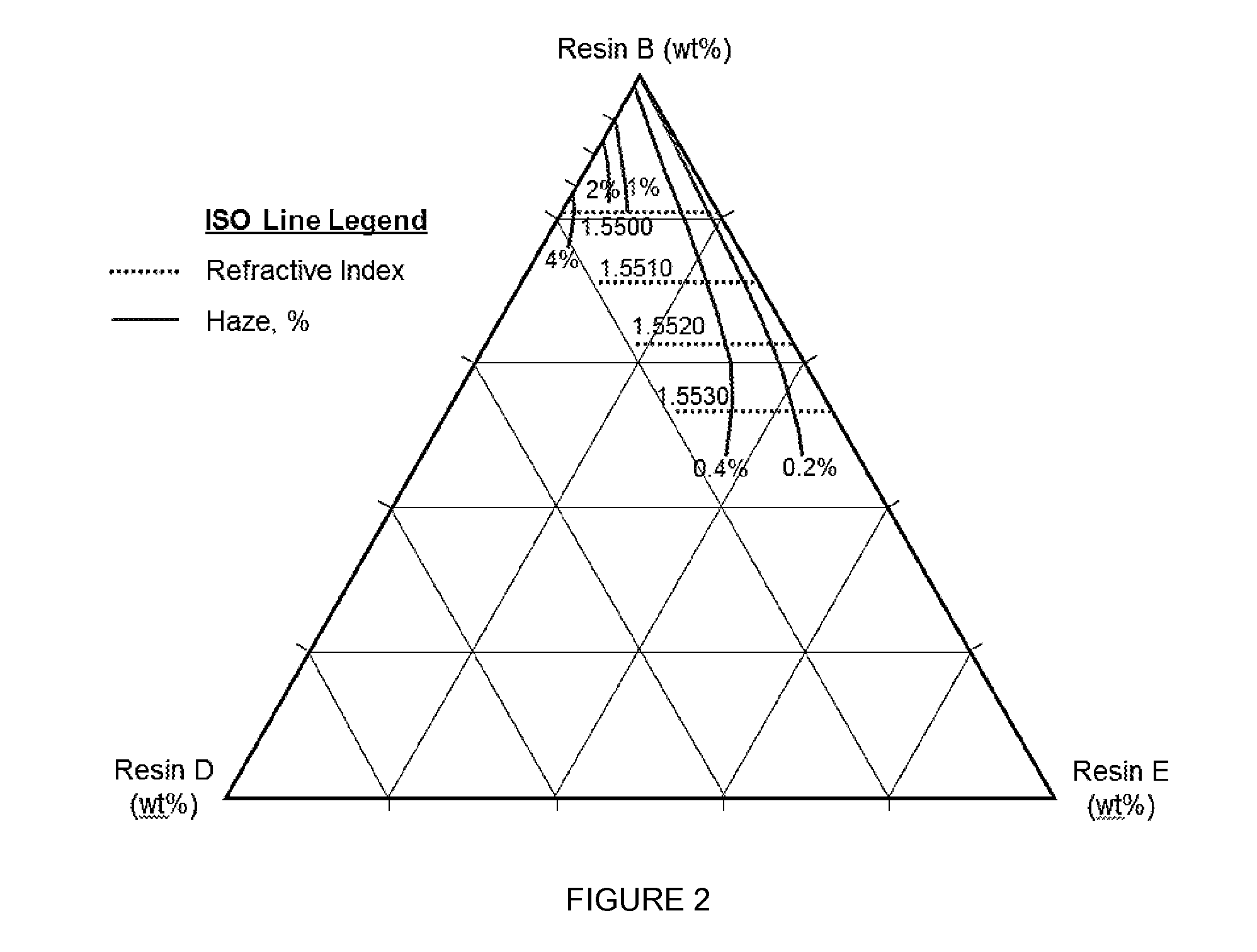Ternary blends of terephthalate or isophthalate polyesters containing eg, chdm and tmcd
- Summary
- Abstract
- Description
- Claims
- Application Information
AI Technical Summary
Benefits of technology
Problems solved by technology
Method used
Image
Examples
examples
[0133]Various commercially-available polyester resins were melt blended in Examples 1-15 below. These materials have the characteristics shown in Table 1.
TABLE 1Diol ResidueInherentResinEGCHDMTMCDViscosityTypeResin(mol %)(mol %)(mol %)(dL / g)PCTTA078220.72PCTTB078220.63PETGC693100.75PETGD693100.59PCTGE386200.73PCTGF198100.75PCTTG072280.67PCTTH065350.64PCTGI505000.76PCTGJ386200.63
[0134]In Table 1, “EG” refers to ethylene glycol, “CHDM” refers to 1,4-cyclohexanedimethanol, “TMCD” refers to 2,2,4,4-tetramethyl-1,3-cyclobutanediol. All resin products contain 100 mol % of terephthalic acid residues. The molar percentages shown above are approximations (within + / − about 2%), since degradation reactions in the reactor can produce byproducts including other diols such as DEG (diethylene glycol), which are subsequently incorporated into the polymer chain, and due to variability in the process control equipment.
[0135]The polyester inherent viscosities were determined in a 60 / 40 (wt / wt) phenol / ...
examples 1-15
[0137]In order to assess the miscibility of multi-component polyester blends, 0.010-inch thick films were extruded using various resin combinations described in Table 2 below. The film samples were made by drying the individual components separately, then mixing them at the extruder (a 2-inch non-vented Davis-Standard extrusion line with a L / D of 30:1). The extrusion conditions included a straight profile with temperature set point of about 520° F. (271° C.) at a production rate of approximately 150 pounds per hour. The materials were extruded through a 24-inch coat hanger die onto a 3-roll stack configuration. The roll temperatures were set to cool the sheet while minimizing stress. A mechanical issue prevented the top-cooling roll from being used, so the film samples were cast instead of being polished on both sides.
[0138]The film samples were then visually inspected to assess the presence of haze (a whitish cast or hue), which is an indication of an immiscible polymer blend. Haze...
example 16
Prophetic
[0143]Repeat Examples 1-15, but replace Resin B with Resin G. Resin G is expected to be directionally less miscible than Resin B when coupled with Resins D and E due to both increasing chemical dissimilarity and its higher inherent viscosity. However, a region should exist on the ternary diagram where haze is low enough for commercial viability.
PUM
| Property | Measurement | Unit |
|---|---|---|
| Fraction | aaaaa | aaaaa |
| Fraction | aaaaa | aaaaa |
| Percent by mass | aaaaa | aaaaa |
Abstract
Description
Claims
Application Information
 Login to View More
Login to View More - R&D Engineer
- R&D Manager
- IP Professional
- Industry Leading Data Capabilities
- Powerful AI technology
- Patent DNA Extraction
Browse by: Latest US Patents, China's latest patents, Technical Efficacy Thesaurus, Application Domain, Technology Topic, Popular Technical Reports.
© 2024 PatSnap. All rights reserved.Legal|Privacy policy|Modern Slavery Act Transparency Statement|Sitemap|About US| Contact US: help@patsnap.com









